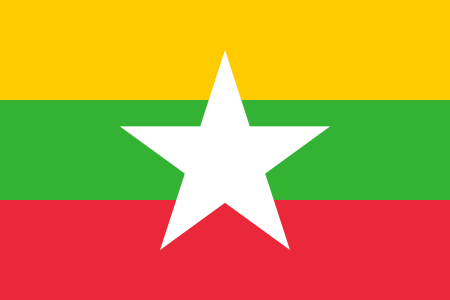The Kanbawzathadi Palace and Hanthawaddy city were founded by King Bayint Naung. He was also the founder of the second Myanmar Empire.
Hantharwaddy City was situated in the Bago township. Bago had three names, which were Bago,Oaktha,( Ussa) and Hantharwaddy.
Before this City was established, the Bago region. The first City was founded by two Mon brothers, Thamala and Wimala, sons of King of Thaton about 825 AD.
The second city was founded by King Byinnya-U in 1365 AD. He moved the capital from Martaban (Moktama) to Bago. This city was located on the east of the Hanthawaddy City. The remains of the brick city-wall of the old city can still be seen on the right side of the Bago Thanutpin car road not far from the present town.
In 1539, King Tabinshwehti of Taungoo dynasty annexed the Bago region and also moved his capital from Taungoo to Bago.
After the death of Tabinshwehti in 1550 AD, his brother in law, King Bayintnaung succeeded to the throne in 1551 AD. King Bayintnaung wanted to built a new city, because the Present City was narrow and old. To built the new city, so he chose a new place which was a muddy flat plain situated on the west of the old city.
In 1553, he constructed the palace buildings enclosed by inner wooden stockade. The palace was named “Kambawzathadi”. Then King Bayintnaung built the whole fortified city called “Hanthawaddy City”, it was completed in 1566 AD. He left a bell with inscription at the Shwezigon, Nyaung U, as referrnce to how he built his Empire. The plan of this City’s shape was square and it was encompassed by a brick city wall and a moat. The length of the brick city wall is about 2600 meters. (1 mile and 4 furlongs) from north to south and 2400 meters (1 mile and 2 furlongs) from east to west. There are five gateways on each side of the city wall and therefore, there are twenty gateways. They were named after King Bayint Naung’s territories, such as Pakhangyi gate, Moktama gate, Thayawaddy gate ….. etc.
According to Myanmar traditional Palace plan, there are eight thrones in a royal palace.
- The Lion throne for great audience hall, used to attend the conferences three times a year
- The Hamsa throne for Jetavan hall, used to pay homage to the like size golden statues of royal ancestors.
- The Conch throne for Baungdawzaung, used to keep the king’s precious headdresses made of solid gold and ornaments with precious stones.
- The Elephant throne for Bye-daik zaung, used to pronounce the Lower rank of king’s courtiers regarding promotion or demotion.
- The Deer throne for southern entrance hall, used to offer daily food to Buddhist monks by the king and chief queen and hold meetings in connection with political and military affairs.
- The Lotus throne for west audience hall, used to pay homage to the King and chief queen by wives of the chieftains.
- The Peacock throne for northern entrance hall, used to accept elephants and horses presented by the remote officers.
- The Bee throne for the king sleeping apartment.
In the contemporary European records, as the Italian merchant Caesars Frederick and English merchant Ralph Fitch. The Hanthawaddy city was a glorious and magnificent capital. It was a great city, very plain and flat. The royal palace was at the centre of the new city. The parts of the Royal palace was richly gilded. The roof of some apartments were covered with solid gold. So the royal Palace was Magnificence and Beauty. The Hanthawaddy City was a great centre of commerce in the 16th century AD.
King Bayint Naung was more powerful than his predecessors. He unified the whole country of Myanmar and other nearby Land. All the nations in Myanmar were united under his control. After King Bayint Naung ruled at Hanthawaddy city for thirty years, he passed away in 1581.
King Nanda, son of King Bayint Naung, ascended the throne. He was not able to organize the nations and the second Myanmar Empire was disunited in 1599.
The Kanbawzathadi Palace remained in ruins for four hundred years. The excavation of Kanbawzathardi palace site was started in 1990.
We found 1800 Lime-stone statues in mount No 1. Iconographically the Buddha images were Hanthawaddy style in the 16th century A.D.
The remains of the royal apartment (king sleeping room)ane treat audience, southern wing and northern wing apartment were unearthed in 1991. The most important findings at the great audience hall site are 200 teak posts, many of which were inscribed in Myanmar and Mon language with the name of towns, regions and royal ministers who sent teak posts for the great audience hall. In our Archaeological Museum, there are exhibitions not only of the findings-antiquities of the Kanbawzathardi Palace site, but also other ancient relice of Myanmar and Mon culture in the Bago region.
Now, we have reconstructed King Bayint Naung’s Kanbawzathardi Palace for the uplift of moral national prestige and dynamism of national patriotism among Myanmar people.


 ပဲခူးတိုင်းဒေသကြီး အစိုးရအဖွဲ့ Bago Region Government – Official Website
ပဲခူးတိုင်းဒေသကြီး အစိုးရအဖွဲ့ Bago Region Government – Official Website